Chapter 1
FRENCH CULINARY
BASICS

France and Food: The Sublime Partnership
Food is sacred in France, and for some, dining is almost a religious experience. Most neighborhood streets are punctuated with tiny shops where M. or Mme Shopkeeper preside over their delectable wares. An open-air farmers’ market pops up once, twice, or even three times a week in towns all over the country. The French are never far from fresh, irresistible fruits and vegetables, luscious wines, cheese and dairy, meat and fish, and outrageously delicious bread and pastry. Even products in the supermarché are lovingly displayed. I always marvel at seeing women, fashionably turned out in that nonchalant but oh-so-perfect French manner, inspecting a peach or plum as if it were a Monet watercolor. This brings me to the French Paradox, a source of irritation for generations of jealous American women. How can French women shop, cook, and eat baguette, foie gras, and duck confit, drink wine every day, and remain maddeningly thin? I maintain that this is not a paradox, it’s a bloody miracle!
Deborah and I wanted to solve this mystery, so we asked French friends and expats for their explanation. Our findings, though unscientific, are plausible: In France, croissants, foie grass, duck confit, and irresistible pastries are meant for company and special occasions, not everyday consumption. Also, in the cities most French women walk every day, and in smaller towns they either walk or bike everywhere. Most importantly, they practice moderation in their diets, consuming wine, meat, and butter in small quantities. And the French do not eat on the run. A leisurely two-hour lunch is ordinaire. They also put effort into shopping and preparing good food, which are calorie-burning activities. Plus, the French do not snack between meals, and many still smoke to control their appetites, which is the only positive thing I can say about the habit. An emphasis is placed on grass-fed, pasture-raised meats and dairy, and minimally processed grains and foods. All of this helps the French to be healthier and leaner.
The omnipresence of lingerie boutiques and extensive lingerie departments in department stores indicates that French women are more interested in remaining svelte and sexy than they are in indulging their epicurean desires. Those willowy women also eat birdlike portions of France’s legendary selections of cheese. This, too, is a natural control, since high quality means that a little goes a long way toward satisfaction. We saw this phenomenon repeated in many different ways during our time in France. After we had lived for several weeks in the non-touristy 15th arrondissement in Paris, M. Trudeau, who owned a tiny cheese store (Mémoire de Fromage) tucked into a space no more than twelve feet wide and perhaps twice as deep, began to smile warmly when we entered his shop. His tempting wares were beautifully displayed in sparkling white and chrome cases, kept at the perfect temperature for each variety. He, too, was immaculate in his long white apron and crisp blue checked shirt.
On one occasion, when we were going to entertain friends for dinner, I asked him for some Brillat-Savarin and gestured toward an arrangement of the buttery-colored cheese with the white bloomy rind. He asked me at what time I would serve the cheese. I said around 9 p.m.
He reached into the case and examined several pieces of the cheese, plucked a massive black-handled knife from its perch, and then deftly separated a perfect portion of cheese and wrapped it in brown paper.
That evening, I removed the cheese from its wrapper about two hours before I planned to serve it, just as he instructed. The goal with wonderfully runny French cheese is to present it at exactly the time when it begins to ooze from its rind. Remarkably, at almost the stroke of nine, the buttery inside of the Brillat-Savarin started to seep its velvety goodness onto the plate! As that smooth, rich flavor melted in my mouth, I realized once again that a little bite satisfied me completely. Who knows, maybe I’d get to be like one of those willowy French women. Now, this tells you just how serious the French are about their ingredients. Believe me, their devotion to quality edibles will soon begin to make you rethink your relationship with food!
To Cart or Not to Cart
There are at least 20 supermarket chains in France, most of which carry the staples you’ll need. The quality of meat, produce, and dairy is very good in these stores, but you’ll have much more fun shopping your local farmers’ market and specialty shops, plus you’ll get even better quality. And what’s the best way to transport all those goodies you find?
The wheeled shopping cart that I swore I’d never use became my favorite accessory almost everywhere we lived. It was much more critical than an Hermès scarf, believe me. A week into our first month-long stay in France, we came panting into the apartment lugging heavy bags of food supplies that we’d hauled four long uphill blocks from local shops and the farmers’ market. As we dumped the bags and flopped into our chairs, Tim declared that the next day we were going to the major retail store Monoprix to buy one of those carts that everyone seemed to be hauling around. Since then, we’ve purchased similar trolleys in every country we’ve called home. For around $20, it’s just about the best travel tool you can buy if you’re planning to cook and eat at home.
What’s in a Sign?
Almost anywhere in France, we find ourselves slavering at the impossibly gorgeous offerings in the windows of the patisseries. There are flaky tarts filled with perfect fruit and brushed with a shimmering glaze; there are delicate petit fours in whimsical shapes and magical flavors. The crisp, melt-in-your-mouth croissants are so delicious that it doesn’t matter if everything within three feet of you will be covered in a blizzard of buttery flakes. The French linger at tiny sidewalk café tables, chatting and people-watching, while enjoying their coffee or wine, macarons, and tartines (open-faced sandwiches). Joining them for a café au lait is always part of our daily ritual.
Clear-eyed fresh fish resting on beds of ice on the sidewalk outside the fishmonger’s store are fascinating. And we can’t help stopping to look at the cheese, sausage, and pâté that vendors have artfully arranged in their windows. Middle Eastern shops tempt us with dates, figs, nuts, exotic spices, and imported delicacies. Mom-and-pop fruit and vegetable stands command our attention, too, as their displays of near-perfect produce and herbs urge us to pick them up, take them home, and do something scrumptious with them.
Usually more than a few of these delights find their way into our shopping bag, even when we are just out for a walk!
As you explore your new neighborhood, look at the sign associated with each shop. When you enter, remember to say “Bonjour.” If you don’t know the shopping and paying procedures observed in that particular store, watch other customers for a few minutes until you get the hang of it. Then have fun choosing your supplies.
When you take your first stroll in a neighborhood, be on the lookout for the following types of shops.
Boucherie (butcher): For meats and poultry.
Boulangerie (bakery): For bread.
Cave à Vins (wine cellar): An essential stop; if you love wine, make friends with your local vendeur de vin—you may get a liberal libation education.
Charcuterie (delicatessen): For dried or cured meats and gorgeous pâtés.
Épicerie (grocery store): Like a corner market; think an upscale 7-Eleven.
Fromagerie (cheese shop): What else can we say?
Marché de Fermiers (farmers’ markets): The farmers’ markets throughout France are astonishing. The array of fresh vegetables and fruits, meats, poultry, fish, and cheeses will thrill your foodie’s heart. The vendors are generally very attentive and kind to non-French speakers. Not only are the products beautiful, but they are also significantly less expensive than what’s available in stores. Many also have street market sections where you can find fun, inexpensive clothes, socks, batteries, toys, and lots of other things. Look online for the days and times when the market comes to your area.
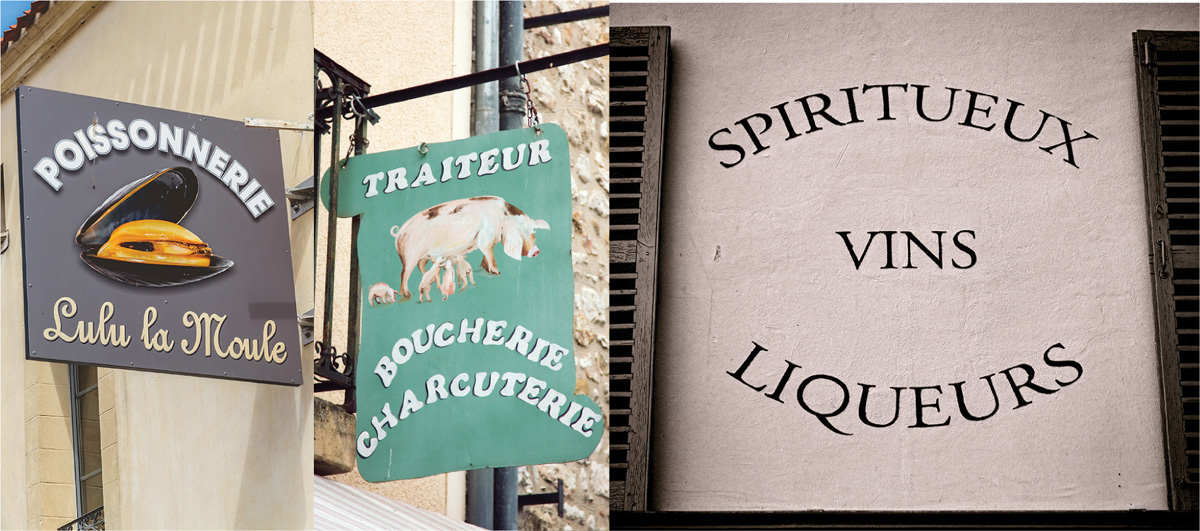
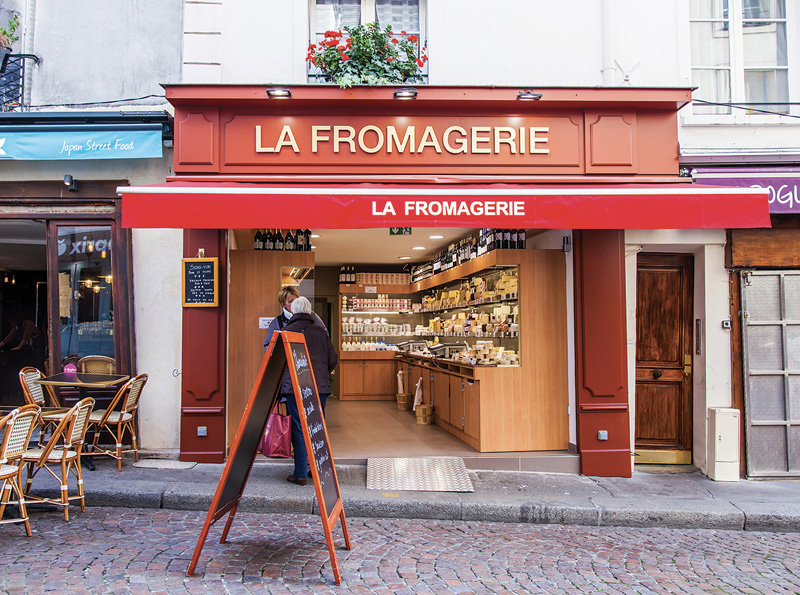
Pâtisserie (pastry shop): For spectacular desserts and sweet treats.
Picard: This is a chain of stores throughout France that sells only frozen foods. It offers superb quality and an amazing variety of French classics. You must stop in, if just to browse. This isn’t your Safeway’s frozen food section! We keep hoping that someone will be smart enough to bring this chain to the United States.
Primeursor (fresh produce): You’ll see fruits and vegetables you’ve never seen before.
Rôtisserie (cooked meat shop): Here you can grab a roast chicken for your picnic or a relaxing evening at home. They often sell other prepared foods, ranging from side dishes to entire meals. If you pick up a roasted chicken, be sure to ask for a portion of the potatoes roasted at the bottom of the pan.
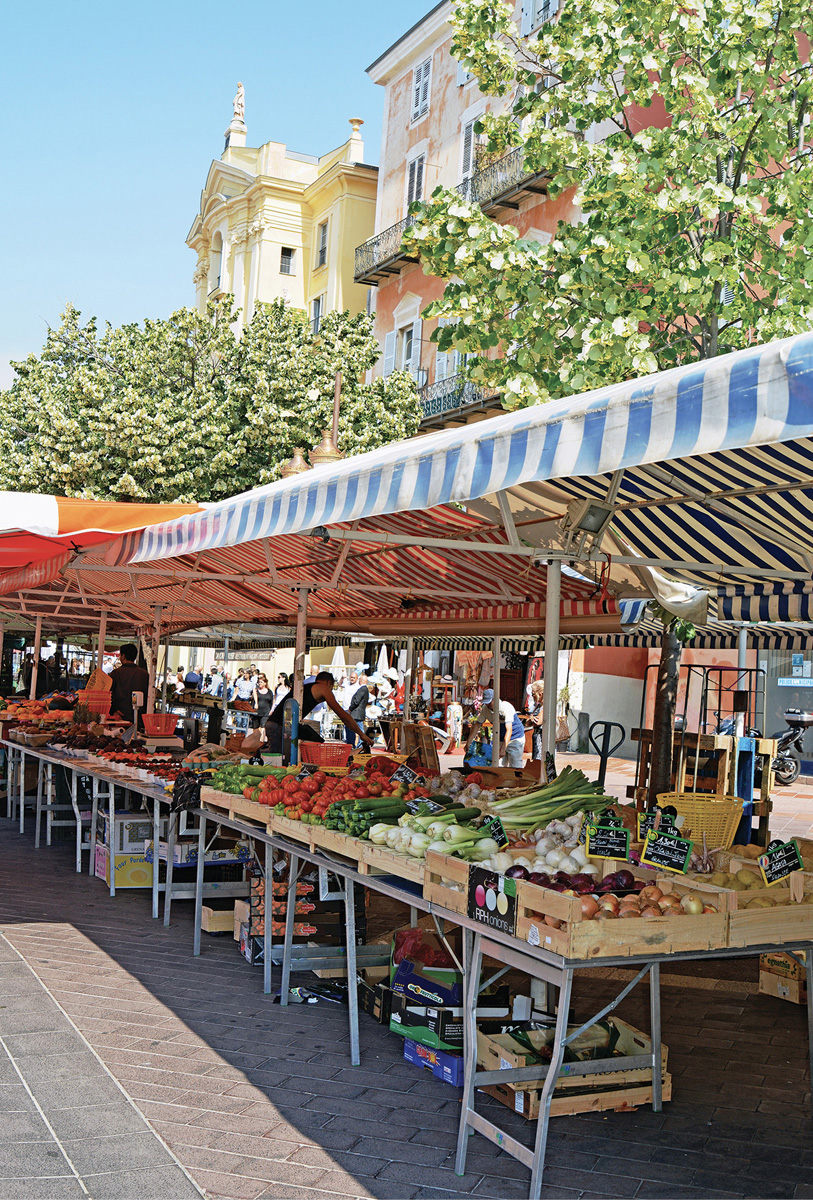
Supermarché (supermarket): You can spend hours perusing all the delights on offer.
Torréfacteur (coffee merchant): Stand back, Starbucks, you have met your match in the grinding wars! These stores sell fresh-ground coffee from around the planet. You can bring your own pastry, but many serve their own and even offer light meals. You won’t find one in the smaller villages, but in big towns, they’re not hard to find. The coffee quality is astounding!
Traiteur (literally “caterer”): These stores can supply you with everything you could possibly want to serve for special occasions. They are stand-alone shops or may be found as a section in supermarkets. You can pick up prepared escargot, foie gras, sometimes whole meals, and make arrangements for party catering, too.
How to Succeed at the French Farmers’ Market
The farmers’ market is as much a part of life in France as the cafés and bistros. The produce is so gorgeous that you’ll want to take a still life photo when you bring your bounty home.
Twice a week, late in the evening, trucks arrived in our neighborhood in Paris. Metallic clattering filled the air as workmen inserted poles into holes in the pavement. They quickly erected frames, from which individual purveyors would create their canvas booths in the morning. The next day we’d find a bustling tent city six blocks long displaying all things edible. Booth after booth of cheese, bread, fish and poultry, olive oil, flowers, herbs, and fresh, plump fruits and vegetables tempted us. The chaos seemed impenetrable and intimidating. Fishmongers with bloody aprons shouted out their specialties, while produce vendors hawked their wares. There was even a traveling cooking school run by the City of Paris where chefs and students huddled over exquisite concoctions while onlookers enjoyed the lesson.
We observed the action in the market for several sessions before plunging into the fray. We quickly learned that customers wait until recognized by the attendant, who uses some kind of French ESP to keep track of which customer is next. Once the transaction begins, he or she bags the items the client indicates, weighs and tags it, and asks for further instructions. It’s a good idea to reconnoiter before your turn, because holding up the procedure is not well received by the vendor or your fellow shoppers. When the order is complete, the worker adds the prices scribbled on a scrap of paper and asks for payment. After a few days, the vendors began to recognize us, and we felt relaxed enough to try out our abysmal French, which amused them. We were inordinately proud of mastering the procedure, and we’d happily trundle home with our bounty, our little cart bouncing along the sidewalk.
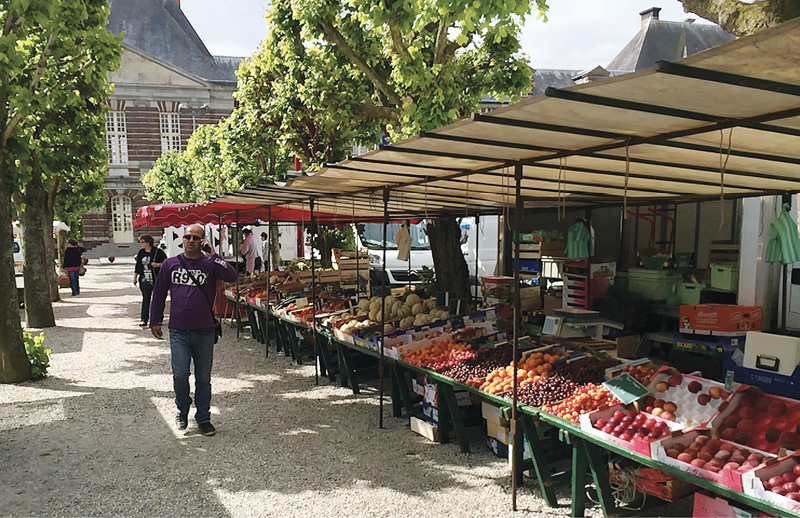
In smaller towns and villages, the weekly farmers’ market feels almost like a county fair. In addition to produce, fish, poultry, and meat, sometimes there are live fowl and rabbits. Strolling along the cobblestones with the lilting calls of vendors touting their wares, the scent of flowers and fresh herbs, and the sight of brilliantly colored fruits and vegetables all surrounded by renaissance buildings and churches, is a moment never to forget. It’s the essence of French life distilled into a Saturday morning shopping trip. Good restaurants are almost always nearby, and you’ll probably see chefs picking out what you might eat for dinner that night if you go out.
Whether you’re shopping in a metropolis or a tiny village, here are some things we’ve learned about farmers’ market shopping that you might find useful:
• Go early because the best of everything will disappear fast.
• Bring a basket or a big bag to corral your purchases. A rolling cart is ideal.
• Remember to bring cash!
• Take a reconnaissance lap around the market before you begin making choices.
• Do ask for samples so you won’t be stuck with a chunk of cheese you don’t love.
• Consider purchasing some still-warm bread, some cheese, and wine for a picnic. The wine vendor will be happy to open the bottle for you.
• Remember that 1 kilo is about 2.2 pounds.
The Superb Supermarket
Get ready for an epicurean coma, and plan for lots of time on your first visit to a French supermarché. You’ll see products you’ve only dreamed about. There will be a lot of shelf space allowed for items like duck, mustard, oils, vinegars, and items with names that you’ll have to consult your dictionary to decode. Let yourself wander among the wonders, and fill up that little cart (which you’ve left at the door with everyone else’s) with all the goodies you’ll need to prepare one of Deborah’s creations from this book.
Auchan, Carrefour, and E. Leclerc are the names of the hypermarchés (supermarkets) you’ll find throughout France. These retailers are the anchor stores in the big commercial centers, and they are usually closed on Sunday mornings. The smaller chains, such as Intermarché, Grand Frais, Lidl, Aldi, Leader Price, Franprix, and the urban Monoprix, are all typically open until midday on Sundays.
Plan ahead because most stores will be closed by Sunday afternoon. If you’ve forgotten the wine, cheese, or bread, you’ll be out of luck until Monday morning. Lunchtime closures at supermarkets are becoming more rare, although they still exist, especially in rural areas. At first, not being able to shop on Sunday seemed inconvenient, but as we began to acclimate to the French joie de vivre, it became our rhythm too. Stocking up for Sunday became part of our pattern, one more step toward our goal of living like the French. There were so many fascinating lessons for us to learn.
For instance, when we attended our first dinner party in France, I was astonished that our hostess worked so hard to entertain us. She presented flaky, hot, dainty hors d’oeuvres, which I knew would have taken hours to prepare, followed by a silky, sublime shrimp bisque. The latter is also an involved recipe. The main course, duck confit, was accompanied by baby potatoes roasted in duck fat, and crisp, lemony haricots verts. The dessert and cheese courses were equally impressive and absolutely delicious. When I described this royal feast to a local friend, she laughed, narrowed her eyes, and informed me that much of that meal must have come from Picard. Everyone she knew served at least one course from Picard, because it makes giving a dinner party a snap.
Of course, I sought out the Picard near me immediately—an easy thing to do, since there’s one in almost every neighborhood in the country. It’s like stepping into a food lover’s igloo! Instead of shelves, there are ranks of open freezers stuffed with hundreds of tantalizing frozen goodies. I spent so much time there on my first visit that it took the rest of the day to thaw out my fingers. Even if you aren’t cooking, it’s a definite food tourist destination.
How to Shop in a French Grocery Store
When you are a new arrival in any city, everyone else seems to know where he or she is going. And they are always in a hurry. Mindful that most people are impatient when a foreigner holds up their progress, Tim and I developed a survival strategy. When the city bustle is overwhelming, we step out of the crowd, get out of the way, and observe what local people are doing and how they’re doing it. In a few minutes, we learn the drill for tasks like buying tickets at the movies, which turnstile to use in the subway, how to queue for the bus, and how to get through the checkout lines in the market. Just taking five minutes to watch the locals can help you go with the flow so that you can avoid feeling frustrated, embarrassed, or discouraged.
The French follow rules carefully, so behaving well can vastly enhance your stay. Here are some tips:
• Whenever you make eye contact or enter a shop it’s always appropriate to say “Bonjour.” And when you leave, remember to say “Merci.”
• Coins are required for shopping carts. Bring a one-euro coin to the supermarket, insert it in the slot, and a cart will be released. When you’ve finished shopping and return the cart, the coin will be returned.
• If you have a rolling cart for taking your items home, leave it near the front door where you see others. Don’t worry, it will be safe.
• Touching the fruits and vegetables is frowned upon in France unless you are putting them in your cart.
• Haggling is unheard of except at flea markets.
• Shouting at your companions across the store or loud talking in restaurants will bring you looks of disdain. Notice how quietly most French people address one another in public and follow suit.
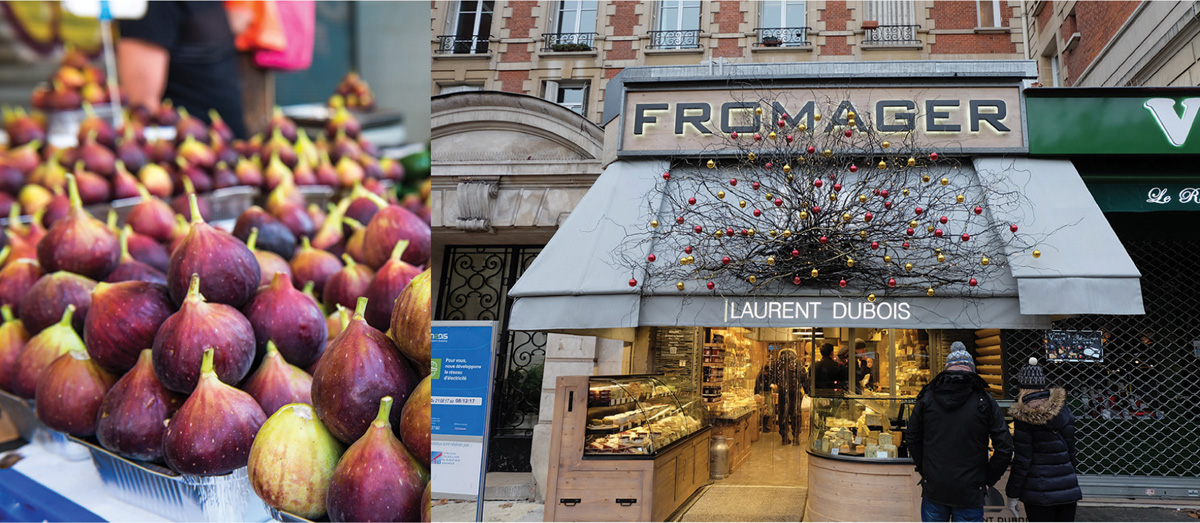
• Bring your own shopping bags, if you have them. Bags are not free in France.
• Make sure you have a chipped credit card.
• If you see a scale with a printer gizmo in the produce section, then you’re supposed to weigh the product and stick the label on the bag. Find the picture of the product you are buying on the touchscreen, and the printer will spit out a sticky label. Be sure to label your produce before you get to the checkout or everyone will be really annoyed. Observe how others are handling their produce and follow suit. If you don’t see a scale, it means the checker will do it.
• Generally, you will bag your own groceries.
• Do not feel stressed when the checker is asking for payment while you’re trying to figure out how to get your stuff in the bags. The customers in line will be staring and sighing, which will make you even more nervous. If you make some observations before you shop, you will notice that local people ignore the stares and tapping toes and take their own sweet time with this process. Relax and smile!
• Organic grocery stores are trending. To find one in your area, do an internet map search with the word “bio,” and you’ll be all set. Bio wines are also very easy to find.
Professional Tips for Cooking in Your French Vacation Rental
Read the recipe: This advice sounds elementary, but in recipe testing sessions for this book, Deborah often tapped the page and tsked when I rushed ahead and skipped an important step! So please pour yourself a nice glass of rosé and take a minute to read the whole recipe before you begin prepping your scrumptious meal.
Mise en place (get your ducks in a row!): Flapping around the kitchen to dig up a spatula while your eggs are burning around the edges can ruin your day, so get out all the ingredients and equipment you need before you begin creating your masterpiece.
Use a prep bowl: Professional chefs and experienced home chefs alike put out a bowl in their prep area for food scraps as they work. It saves steps and eliminates drips on the way to the trash. If you’re renting a farmhouse, the pigs will love you for your offerings.
Lids: Many times you’ll find that your rental kitchen doesn’t provide proper lids for all the pans, so you’ll have to improvise. Try flipping a sauté pan over the one you’re cooking with, or use a plate or saucer that’s the right size to cover your pan.
Strainer: The lack of this handy tool on vacation can be a serious drag, so you’ll have to be creative! A box grater turned on its side makes a good tool for filtering out liquid. A coffee filter poked with holes can do in a pinch. Your own hand makes a dandy egg separator.
Treat your herbs like flowers: Limp herbs are useless. If you trim the stems and put the herbs in a glass of water, and then cover it with a plastic bag, you can store them in the fridge successfully for quite a long time.
Put the lid on y our pot when boiling water: This seems obvious, but you’d be surprised how many people don’t realize how much faster they’ll get results by using a lid. Also, you can rest a wooden spoon across your uncovered pot and when the rising foam hits the spoon, it will simmer down.
No salad spinner?: Here’s a better way: Put your freshly washed produce into a clean kitchen towel, collect the corners together, and wave it around until the greens are dry. You’ll get the added benefit of a bicep workout!
Put a damp paper or kitchen towel under your cutting board: Your board will be stable and chopping will be less of a task.
Yearning for chocolate chips?: Chocolate chips are an American staple so you may not be able to find them in France. Just break up a chocolate bar and chop it up.
No toaster? No problem!: Drop some butter or olive oil in a pan over medium-high heat. Pop in your bread and fry away. It will be the best toast you’ve ever had.
Use a salt bowl: It’s unlikely that you’ll find a fancy salt pig in a rental, so just grab a bowl, pour in some salt, and set it near the stovetop. It will save time and remind you to salt your food.
Please use good quality salt: All salts are not the same. The sad, hard granulated salt that most Americans seem to use does not do justice to the food it seasons. Once you discover the fabulous world of salt out there, you will never be able to go back to the same old salt. We highly recommend investing in some fleur de sel. This salt tastes like the sea, and it enhances the flavor of food instead of just making it taste salty.
Taste, taste, taste: Ingredients are not created equally, and what you get at home may not be like what you get in France. Make sure to always adjust seasonings so that the meal you’re creating appeals to your tastes.
We have included a weight, measure, and temperature conversion chapter at the end of this book. As you cook, pay particular attention to liquid versus dry ingredients. If not in the United States, also take care to set your temperatures to Celsius not Fahrenheit. The results could be disastrous if you interpret 300°F to be 300°C.
Dining Alfresco
France’s natural beauty is so alluring that dining alfresco is an essential part of the culture. Every decently sunny day brings people out picnicking in the parks, beside the rivers, and under the trees along country roads. In the summertime, the spacious green meadow below the Eiffel Tower is full of people enjoying their picnics as they watch the French Open on the mammoth TV screen erected below the tower. Lounging there while enjoying Deborah’s sensational Chopped Endive, Blue Cheese, Persimmon (Kaki), and Walnut Salad (see page 200) and a baguette slathered with a country pâté, all washed down with a crisp rosé, is just about as good as it gets.
Another authentic spot for a Paris picnic is below the Hôtel de Ville (City Hall), on the Seine river. We often gather there with local friends on summer evenings. Everyone brings food to share—salads, pâté, cheese, baguette, olives, sweets, and of course, wine. Watching the sun sink behind Notre Dame as the lights of the city begin to glisten on the Seine, sharing stories and laughter with good friends, are memories I’ll always treasure.
Traveling through the country, you’ll find no shortage of charming spots to stop and enjoy the view. In every town you’re likely to see a welcoming park, and most highways offer rest stops that include picnic tables. If you don’t have the time or place to cook, no matter. There is a patisserie, charcuterie, and a wine store in every village so you can assemble a feast wherever you go.
If you are near Dijon in September, don’t miss the Fantastic Picnic! You can dine in the middle of vineyards or in a historic chateau. The Fête de la Gastronomie is held nationwide on the fourth weekend of September.




